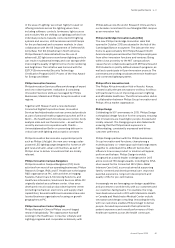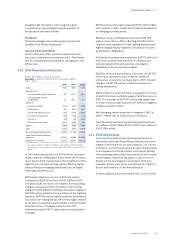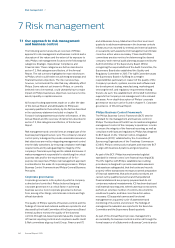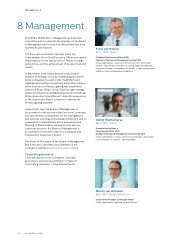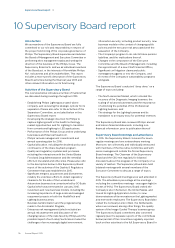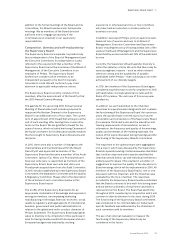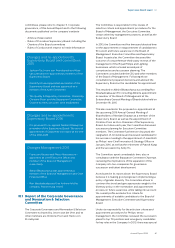Philips 2015 Annual Report Download - page 71
Download and view the complete annual report
Please find page 71 of the 2015 Philips annual report below. You can navigate through the pages in the report by either clicking on the pages listed below, or by using the keyword search tool below to find specific information within the annual report.Risk management 7.5
Annual Report 2015 71
The correctness of disclosures provides investors and
other market professionals with signicant information
for a better understanding of Philips’ businesses.
Imperfections or lack of clarity in the disclosures could
create market uncertainty regarding the reliability of the
data presented and could have a negative impact on
the Philips share price.
The reliability of revenue and expenditure data is key
for steering the business and for managing top-line and
bottom-line growth. The long lifecycle of healthcare
sales, from order acceptance to accepted installation,
together with the complexity of the accounting rules for
when revenue can be recognized in the accounts,
presents a challenge in terms of ensuring there is
consistency of application of the accounting rules
throughout Philips Healthcare’s global business.
Philips is exposed to non-compliance with data privacy
and product safety laws.
Philips’ brand image and reputation would be
adversely impacted by non-compliance with various
data protection and product safety laws. In light of
Philips’ digital strategy, data privacy laws are
increasingly important. Also, Philips Healthcare is
subject to various (patient) data protection and safety
laws. In Philips Healthcare, privacy and product safety
and security issues may arise, especially with respect to
remote access or monitoring of patient data or loss of
data on our customers’ systems. Philips is exposed to
the risk that its products, including components or
materials procured from suppliers, may prove to be not
compliant with safety laws, e.g. chemical safety
regulations. Such non-compliance could result in a ban
on the sale or use of these products.
Philips operates in a highly regulated product safety
and quality environment. Philips’ products are subject
to regulation by various government agencies,
including the FDA (US) and comparable foreign
agencies. Obtaining their approval is costly and time
consuming, but a prerequisite for market introduction.
A delay or inability to obtain the necessary regulatory
approvals for new products could have a material
adverse eect on business. The risk exists that product
safety incidents or user concerns could trigger FDA
business reviews which, if failed, could lead to business
interruption which in turn could adversely aect Philips’
nancial condition and operating results. E.g. the
voluntary, temporary suspension in 2014 of new
production at our Healthcare facility in Cleveland, Ohio
targeted to further strengthen manufacturing process
controls after certain issues in this area were identied
during an ongoing FDA inspection.
7.6 Financial risks
Philips is exposed to a variety of treasury risks and other
nancial risks including liquidity risk, currency risk,
interest rate risk, commodity price risk, credit risk,
country risk and other insurable risk.
Negative developments impacting the global liquidity
markets could aect the ability of Philips to raise or re-
nance debt in the capital markets or could lead to
signicant increases in the cost of such borrowing in the
future. If the markets expect a downgrade or
downgrades by the rating agencies or if such a
downgrade has actually taken place, it could increase
the cost of borrowing, reduce our potential investor
base and adversely aect our business.
Philips operates in approximately 100 countries and its
earnings are therefore inevitably exposed to
uctuations in exchange rates of foreign currencies
against the euro. Philips’ sales are sensitive in particular
to movements in the US dollar, Japanese yen and a
wide range of other currencies from developed and
emerging markets. However, Philips’ sourcing and
manufacturing spend is concentrated in the Eurozone,
United States and China. Therefore the net (revenues
less spend) sensitivity of Income from Operations to US
dollar and Chinese renminbi is relatively small. Income
from Operations is sensitive to movements in currencies
from countries where the Group has none or small
manufacturing/sourcing activity such as Japan and a
range of emerging markets such as Russia, Korea,
Indonesia, India and Brazil.
The credit risk of financial and non-financial counterparties
with outstanding payment obligations creates exposures for
Philips, particularly in relation to accounts receivable with
customers and liquid assets and fair values of derivatives and
insurance receivables contracts with financial counterparties.
A default by counterparties in such transactions can have a
material adverse effect on Philips’ financial condition and
operating results.
Philips’ supply chain is exposed to uctuations in
energy and raw material prices. Commodities such as
oil are subject to volatile markets and signicant price
increases from time to time. If Philips is not able to
compensate for, or timely pass on, its increased costs
to customers, such price increases could have an
adverse impact on its nancial condition and operating
results.
Philips is exposed to interest rate risk, particularly in
relation to its long-term debt position; this risk can take
the form of either fair value or cash ow risk. Failure to
eectively hedge this risk can impact Philips’ nancial
condition and operating results.
For further analysis, please refer to note 31, Details of
treasury / other nancial risks.
Philips is exposed to a number of dierent scal
uncertainties which could have a signicant impact on
local tax results.
Philips is exposed to a number of dierent tax
uncertainties which could result in double taxation,
penalties and interest payments. These include transfer
pricing uncertainties on internal cross-border deliveries


